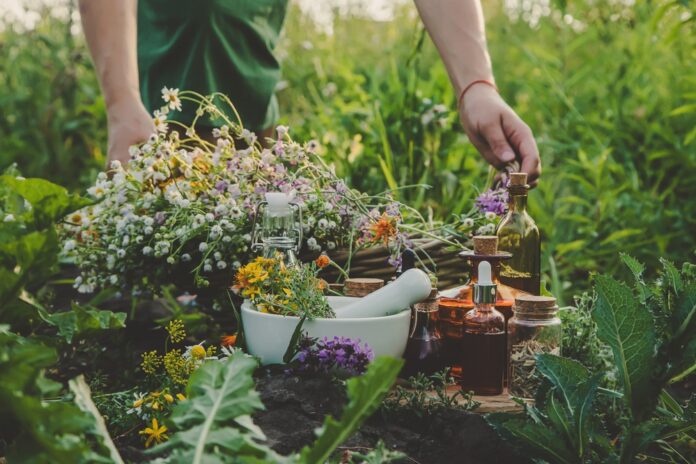Imagine stepping into your backyard and harvesting fresh, aromatic herbs to create natural remedies for your family’s common ailments. Growing a medicinal herb garden is not only a rewarding hobby but also a practical way to ensure you have access to organic, high-quality herbs year-round. In this guide, we’ll walk you through the steps to cultivate your own healing garden—from planning and selecting herbs to planting and maintaining your green oasis.
Why Grow a Medicinal Herb Garden?
Cultivating your own medicinal herbs allows you to support your family’s health with sustainable gardening practices. By growing herbs at home, you have control over their growth conditions, ensuring they are free from pesticides and chemicals. Additionally, it can be cost-effective compared to purchasing herbal remedies, and it brings the joy of gardening and a deeper connection with nature.
Planning Your Herb Garden
Define Your Intentions
Before you put seeds in the soil, consider what you hope to achieve. Are you aiming to grow herbs for personal use or to share with others? Identifying your goals will help you choose the right herbs and decide how much space you need.
Assess Your Space and Energy
Determine how much time and effort you can commit. Whether you have a spacious backyard or a small balcony, you can tailor your garden to fit your circumstances. Container gardening is an excellent option for limited spaces and allows for easier control over soil conditions.
Understand Your Climate and Soil
Knowing your climate zone and soil type is crucial. Some herbs thrive in specific conditions, and planting them in unsuitable environments can lead to poor growth or invasiveness.
Choosing the Right Herbs
Starting with easy-to-grow herbs can set you up for success. Here are some beginner-friendly medicinal plants:
Calendula (Calendula officinalis)
- Uses: Anti-inflammatory, skin healing.
- Growing Conditions: Prefers full sun to partial shade and well-drained soil.
Calendula is known for its bright orange and yellow flowers and can be used in salves and teas to promote skin health.
Chamomile (Matricaria chamomilla)
- Uses: Relaxation, digestive aid.
- Growing Conditions: Requires full sun and light, sandy soil.
Chamomile’s delicate flowers are perfect for soothing teas.
Lavender (Lavandula spp.)
- Uses: Aromatherapy, stress relief, skin care.
- Growing Conditions: Needs full sun and well-drained soil.
Lavender’s aromatic properties make it a staple in medicinal gardens.
Lemon Balm (Melissa officinalis)
- Uses: Mood elevation, anxiety relief.
- Growing Conditions: Thrives in full sun to partial shade and moist soil.
Lemon balm can be used in teas and tinctures for its calming effects.
Peppermint (Mentha × piperita)
- Uses: Digestive aid, headaches.
- Growing Conditions: Prefers partial shade and moist soil.
Be cautious with mint, as it can be invasive; consider planting it in containers.
Echinacea (Echinacea purpurea)
- Uses: Immune support.
- Growing Conditions: Requires full sun and well-drained soil.
Echinacea is also known as coneflower and attracts pollinators to your garden.
Planting Your Medicinal Herbs
Start with Transplants or Seeds
For beginners, using transplants can be easier, especially for perennials. However, growing from seeds allows for a greater variety and can be more cost-effective.
Prepare the Soil
Use well-composted soil to provide essential nutrients. Ensure good drainage to prevent root rot. Consider creating raised beds or using containers for better soil control.
Consider Companion Planting
Some herbs grow well together, while others can inhibit growth. For example, avoid planting fennel near other herbs due to its allelopathic properties.
Maintaining Your Herb Garden
Watering and Feeding
Herbs generally prefer moderately moist soil. Overwatering can be just as harmful as underwatering. Apply organic compost annually to replenish nutrients.
Pruning and Harvesting
Regularly prune your herbs to encourage bushier growth and prevent flowering if you want to prolong leaf production. Harvest in the morning when essential oils are at their peak.
Managing Invasive Herbs
Herbs like borage and mint can spread aggressively. Keep them in check by planting them in pots or designated areas.
Harvesting and Preserving
Drying Herbs
Dry herbs by hanging them in small bundles in a cool, dark, and well-ventilated area. Once dried, store them in airtight containers away from light and moisture.
Using Your Herbs
Create teas, tinctures, salves, and other remedies. For example, infuse calendula in oil to make a healing salve, or use chamomile flowers for a calming tea.
Resources and Where to Buy
Starting your medicinal herb garden is easier with the right resources. Consider purchasing seeds or starter plants from reputable suppliers like:
- Strictly Medicinal Seeds: Devon Young mentions purchasing numerous medicinal seeds from this supplier to expand her herbal apothecary (source).
- Mountain Rose Herbs: Jill McSheehy suggests testing recipes using small quantities of herbs purchased from here to decide which ones to grow (read more).
Educational Resources
Books:
- The Backyard Herbal Apothecary by Devon Young
- Medicinal Herbs: A Beginner’s Guide by Rosemary Gladstar
- Healing Herbal Infusions by Colleen Codekas
Online Courses: - Chestnut School of Herbal Medicine
Conclusion
Embarking on the journey of growing a medicinal herb garden is both fulfilling and beneficial. It allows you to become more self-sufficient and connect with nature. Start small, be patient, and enjoy the process of nurturing plants that will, in turn, nurture you and your family.
By cultivating healing herbs in your own garden, you’re taking a proactive step towards a healthier lifestyle and embracing the timeless tradition of herbal medicine. Happy gardening!


